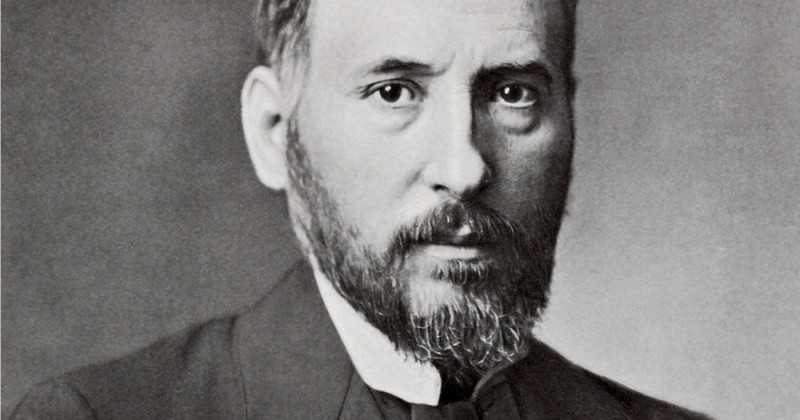Santiago Ramón y Cajal: biografía de este pionero de la neurociencia

Las investigaciones de este científico español le hicieron ganar un premio Nobel.
Santiago Ramón y Cajal (1852-1934) es reconocido como uno de los fundadores de la neurociencia contemporánea. Es así porque los trabajos que realizó en histología y anatomía han sido fundamentales para describir el funcionamiento de nuestras redes neuronales. Además, su biografía está llena de historias relacionadas no solo con la ciencia, sino con el arte e incluso la actividad militar.
En este artículo haremos un repaso por la biografía de Santiago Ramón y Cajal, pasando por algunos de los elementos más representativos de la vida y obra de uno de los científicos más importantes del siglo XX.
- Artículo relacionado: "Ramón y Cajal explicó cómo funciona el cerebro con estos dibujos"
Breve biografía de Santiago Ramón y Cajal: ¿quién fue?
Santiago Ramón y Cajal was born on May 1, 1852 in Petilla de Aragón, northern Spain. He was the son of a surgeon who later trained as a physicist.
Although he would become one of the most important scientists in history, Ramón y Cajal's interests during his adolescence and youth were very much focused on art and physical activity, and not so much on schoolwork. Nevertheless, and in spite of the fact that there seems to be no relation, these artistic interests were fundamental skills for the formation and scientific development of Ramón y Cajal later on.
At the young age of 16, together with his father, he carried out various studies in anatomy based on drawings that Ramón y Cajal himself had made. This was one of his first approaches to anatomy and art.This was one of the antecedents of his interest in the practice of dissecting.
In the year 1873, Ramón y Cajal graduated from the Zaragoza School of Medicine.. There he had followed the teachings of the German Theodor Schwann, a researcher specialized in the study of the cell as the basic structural unit of all living organisms.
Later, in the political context of conflict in Spain, Ramón y Cajal became a military doctor in the services of the Spanish army. military doctor in the services of the Spanish army.. As part of this, he spent some months in Cuba, and it was not until his return to Zaragoza that he continued his studies in histology and anatomy.
In 1879 he became an associate professor at the University of Zaragoza, where there was also a physiology laboratory that allowed him to approach the studies done through the microscope. studies made through the microscope.. In the same year, he formed a family with Silveria Frañañás, with whom he had seven children.
In 1881 he became a professor at the University of Valencia, and later at the universities of Barcelona and Madrid. In the latter city he founded the laboratory of Biological research in 1922, now known as the Cajal Instituteone of the most important neurobiology research centers in the world.
The foundations of contemporary neuroscience
Santiago Ramón y Cajal, together with the Italian anatomist Camillo Golgi, was the first histologist to suggest that neurons are the primary structures and functional units of the nervous system, and that they are also the primary structures of the nervous system.and that they are, moreover, structures that are directly connected to each other, but are relatively autonomous.
In other words, thanks to his research it was possible to learn that neurons are cells that communicate with each other through different elements distributed in cellular spaces (such as axons). This laid the foundations for the development of neuroscience as we know it today.
In order to analyze the individual structure of neurons, Ramón y Cajal used a test called the "tin method". used a test called the "silver staining method," which Camillo Golgi had developed. Through this test, both researchers found that the nervous system functions as a kind of mesh or network.
This was an important contribution, since it was previously thought that the nervous system was composed of separate cells, which communicated by continuity (Golgi himself thought the latter).
The development of their research and the perseverance of Ramón y Cajal in perfecting the staining method allowed them to obtain clear images of nerve endings. clear images of the nerve endings and to suggest that neurons and to suggest that neurons communicate by contiguity, through the ramifications of the dendrites and axons that connect the neuronal bodies.
The legacy of this Spanish researcher
The use of the silver chromate staining method began with the study of bird and small mammal embryo brains. Especially with the brains of embryos, it allowed them to obtain clear colorations of the gray matter of the brain, which was later transferred to the study of human neuronal activity.
For all of the above, in 1906 both researchers were awarded the Nobel Prize in Physiology. Likewise, all his work was compiled in a book that has become one of the classics of neuroscience: The Nervous System of Man and Vertebrates..
Finally, although Ramón y Cajal did not directly study neuropathology, much of the knowledge and research he developed has been used to understand the functions and alterations of neuronal systems.
Bibliographical references:
- González, M. (2006). Santiago Ramón y Cajal, one hundred years after the Nobel Prize. Ciencias, 84: 68-75.
- New World Encyclopedia. (2015). Santiago Ramón y Cajal. Retrieved June 13, 2018. Available at http://www.newworldencyclopedia.org/entry/Santiago_Ramón_y_Cajal.
(Updated at Apr 13 / 2024)